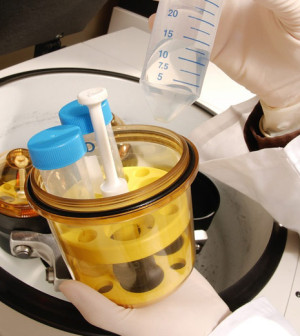- Navigating Your Midlife Crisis: Embracing New Possibilities
- City Raccoons Showing Signs of Domestication
- Mapping the Exposome: Science Broadens Focus to Environmental Disease Triggers
- One Week Less on Social Media Linked to Better Mental Health
- Your Brain Changes in Stages as You Age, Study Finds
- Some Suicide Victims Show No Typical Warning Signs, Study Finds
- ByHeart Formula Faces Lawsuits After Babies Sickened With Botulism
- Switch to Vegan Diet Could Cut Your Greenhouse Gas Emissions in Half
- Regular Bedtime Does Wonders for Blood Pressure
- Dining Alone Could Mean Worse Nutrition for Seniors
3 Drugs Identified to Potentially Fight Zika Virus

Three already existing drugs may offer pregnant women and their developing fetuses protection against the damaging effects of Zika virus, a new multicenter study reports.
Researchers identified these three potential Zika treatments in the laboratory by screening 6,000 different compounds that included already-approved drugs and clinical trial drug candidates.
“We specifically in this screen tried to take advantage of compounds that are already FDA-approved or in some stage of clinical development,” said study co-author Emily Lee. She’s a graduate student of molecular biology at Florida State University in Tallahassee.
One of the drugs, sold as Niclosamide, is already on the market as a treatment for tapeworm. But it appears to also have antiviral properties that inhibit Zika from replicating, the researchers reported.
Another antiviral drug potentially effective against Zika is PHA-690509. This is a medication that is currently in development that works by interfering with gene expression, the study authors said.
And finally, investigators identified a third medication awaiting U.S. Food and Drug Administration approval that doesn’t directly act against Zika, but may be able to protect the brain cells of developing fetuses against viral damage. The drug, Emricasan, inhibits a natural process that causes programmed cell death.
“This compound wouldn’t necessarily be good for treating infections by itself, because it can’t stop the infection, but maybe we can use it to buy time and protect the cells against the infection,” Lee said.
Zika virus is mainly spread via mosquito bites. Infection poses significant risks to pregnant women, because it can cause a birth defect called microcephaly, which results in babies born with undersized heads and underdeveloped brains.
The virus is currently being actively transmitted in two areas of metropolitan Miami, according to the U.S. Centers for Disease Control and Prevention. Zika has achieved epidemic status in the U.S. territory of Puerto Rico, and is widespread throughout Central and South America.
The new drug research moved at breakneck pace, identifying the three compounds in a couple of months thanks to a large-scale collaboration between the U.S. National Institutes of Health, Johns Hopkins University in Baltimore, Florida State University, the Icahn School of Medicine at Mount Sinai in New York City, Emory University in Atlanta, and Zhejiang University in China, Lee said.
Researchers already have started testing the drugs in mice, but much work needs to be done before they’ll be available to humans, Lee noted.
For example, researchers have to test in mice and primates whether the drugs are effective at all against Zika in living creatures, and whether they are safe to take during pregnancy, she explained.
“It could be very fast, or it could take a long time,” Lee said of the process. “If that works really well in mice, with no problems, it would be much easier to move it into primates right away and then into clinical trials right away. But if there are any problems, it could extend the process out.”
Infectious disease expert Dr. Amesh Adalja said the “possible repurposing of existing compounds that may be already in use for another indication is an important part of developing a rapid response to an emerging infectious disease outbreak such as Zika.”
According to Adalja, a senior associate with the UPMC Center for Health Security in Baltimore, “This new data is very promising and may lead to effective antiviral therapies against Zika. However, it will be equally important to develop a concept for how these drugs could be used.”
Most people with Zika don’t have any symptoms (“asymptomatic”) and are unlikely to realize they’re infected, according to the CDC.
“It is extremely difficult to effectively intervene on asymptomatic patients given that they have no symptoms and thus no signal that they are harboring the virus,” Adalja said.
Lee suggested that if the antiviral drugs prove effective, public health officials might choose to deploy them in areas with active Zika infection.
“If people are being used as reservoirs for the virus, we might want to start proactively treating populations where Zika is in circulation, to stop the circulation,” she said.
However, she warned people against buying Niclosamide, the only one of the three drugs already on the market, for off-label use against Zika at this point.
“Even if we think it’s going to work, we don’t want to take a chance with people,” Lee said. “We just don’t know enough about it yet. Wait and see what our groups come up with.”
The study was published Aug. 29 in Nature Medicine.
More information
For more on the Zika virus, visit the U.S. Centers for Disease Control and Prevention.
This Q & A will tell you what you need to know about Zika.
To see the CDC list of sites where Zika virus is active and may pose a threat to pregnant women, click here.
Source: HealthDay
Copyright © 2025 HealthDay. All rights reserved.










